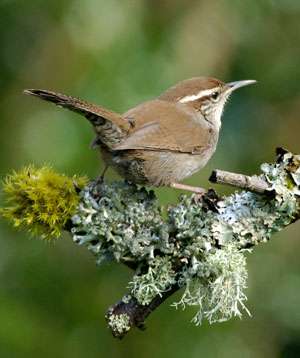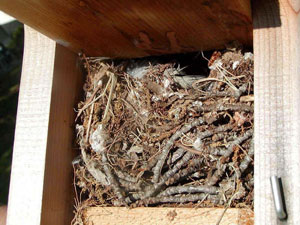

Contents: Species, Interesting Facts, Identification, Song, Distribution, Preferred Nesting Habitat, Diet, Nesting Behavior, Nestboxes, Nestbox Location, Recommended Distance Between Nestboxes, Monitoring, Nesting Timetable, Longevity, More Info. Also see photos of nests and eggs.
Species: Pronounced like Buick (car). Acronym is BEWR. Multiple subspecies, several of which have gone extinct. Historically may have been referred to as San Diego Wren. Also see House Wren and Carolina Wren.
- Named for J.J. Audubon’s friend Thomas Bewick, a British engraver.
- Populations have declined alarmingly in some areas. BBS surveys reported 75% decline in Kentucky route from 1967-1977.
- Usually only pauses 1-2 seconds at a time in between walking, hopping and climbing.
- Unlike the House Wren, the Bewick’s Wren is not known for attacking other birds nests, making multiple dummy nests, or filling up tall nestboxes to the top with nesting material. [MAY take over Carolina Wren nest site? (Laskey 1946) Dr. Sutton found no evidence of this (Bent)]
- Egg size increases with each egg laid.
- Are reportedly good at keeping wasps out of active nestboxes.
- Songs vary by range. Learns song from neighboring males before first winter. (Cornell.)
- If a cowbird lays an egg, may desert nest or remove it.
Identification: Distinctive white eyeline, whitish breast, drab/mousy chocolate-brown to grayish brown back (in the East they are more reddish-brown vs. gray in West). Long barred and white-speckled corners on tail (visible when tail is fanned), tail is wagged from side to side. Long pointy bill that curves down slightly. Grayish belly. Sexes look the same. Active, inquisitive, noisy. Bigger than a House Wren (which lacks white eye stripe); smaller and more slender, with a longer tail than a Carolina Wren (which is more rusty colored and has buffier belly). Sibley’s listed Bewick’s as 5.25″ length (vs. 5.5″ for Carolina); 0.35 oz (vs. 0.74 oz. for Carolina)
Song: Varies depending on location. Multiple (10-15) songs, consisting of sweet, loud, cheerful, complex whistles and trills. Sounds a little like a Song Sparrow. Also raspy/buzzy scolding.
Distribution: See BBS Map. Listed as endangered, threatened or Species of Concern in WI, IL, IN, OH, PA, MD, VA, NC, MI, TN, SC, GA, KY. Generally found in dry, fairly open habitats. Since the 1920s-1970s, has disappeared or declined in many areas, perhaps due in part to competition from birds like the House Wren, since declines are correlated with increases in House Wren densities, and House Wrens using nestboxes (Bibbee 1947), and other facts (e.g., cats, etc.). Largest breeding densities where House Wren densities are low (Sauer 1996). In one study in Kansas, out of 32 nest attempts, House Wrens caused 81% of nesting failures (Kennedy & White 1996). Now mostly found in parts of AZ, TX and CA, southwest British Columbia. Year round resident in some areas, some migrate.
Preferred Nesting Habitat: Mixtures of thick scrubby vegetation and open woodland and farmyards, fence rows. Eastern populations often around farm outbuildings (e.g., shed, garage, barn) near brushy or wooded areas in cleared or fairly open country. May prefer denser (less open) habitat than House Wrens when ranges overlap. Western in brushy areas usually away from humans.
Diet: Insects (including eggs and larvae) such as bugs, beetles, bees and wasps, caterpillars, some butterflies and moths, grasshoppers, crickets, flies, spiders. Some vegetable matter (fruit pulp, seeds) especially during winter. They do like mealworms. Usually forage on the ground up to about 4 to 10 feet off the ground. Usually monogamous, but a male may “service” more than one female (Kennedy & White, 1997.)
Nesting Behavior: Not aggressively territorial like House Wrens. May form pairs in spring, and stay paired up during the winter. Begin breeding when 1 year old.
Nestboxes: May prefer natural cavities. See recommended specs for nestboxes (similar to those for House Wrens) . May like slot boxes (easier to get sticks inside) with slot 1-1.25″ high. Adults may roost individually in a nestbox. Young roost together for about a month. Have been known to nest on exposed shelves and ledges (including crevices in rock ledges), knotholes in fallen trees, nestboxes, natural cavities (e.g., in snags, poles or fence posts), woodpecker cavities, nooks or crevices in or around buildings (e.g., sheds, garages and barns), under buildings, in abandoned cars, old shoes, cans, empty barrels, drainpipes, and in dense brush heaps and hay. They may chose inconvenient places to nest in (e.g., a water bottle pouch on the handlebars of a bicycle) but remember that it is illegal to disturb the active nest of a native bird without a permit. May only use 5-20% of available nestboxes – extra boxes may promote House Wren competition.
Nestbox Location: Nests may be 0-32 feet above ground, typically 3 – 6 feet above ground. Five to ten feet above the ground may be preferred (Corkran.) Place near brushy areas or thickets with an open overstory. In the West, near scrubby chaparral or piñon-juniper shrublands. Okay to put near buildings. (Dobkin)
Recommended distance between nestboxes: ? At least 100 feet apart, with screening vegetation/structure in between. (Corkran) Might find one pair per 0.6 – 1.2 acres, although they can defned a territory of 3-17 acres depending on how open it is (more open = larger territory). (Dobkin)
Monitoring: Young may fledge prematurely on Day 12 or after if handled! When disturbed, female may flush but stay nearby and scold. Others sit tight on eggs.
Nesting Timetable (typical): Nesting cycle is 52-53 days (Bent)
- Excavation or nest site selection: Secondary cavity nester (meaning they use existing cavities.) Starts in late winter/early spring (Feb-June, depending on location). Residents may start earlier than migrating birds.
- Nest construction: Both male and female help build nest, with male usually starting base (and female rearranging it). (Male may start a nest and abandon it if he doesn’t find a mate, but does not make lots of dummy nests like a House Wren.) Work on it all day long. Usually takes 7-8 days, but there may be intervals with no activity. When rushed (e.g., during egg laying period or re-nesting attempt) can build a nest in 1-2 days. Male may start second nest while female is still with first brood. Bulky nest (sometimes domed) with a deep cup of grass, feathers, hair, plant down, moss and dead leaves on a base of short twigs/sticks, rootlets, chips/leaf debris, spider egg cases, oak catkins. May have a wider variety of material in the base, with finer materials in the cup. Often snakeskin or cellophane in cup, which is deep and tiny and may be in a back corner. May be a little more “organized” looking than a Carolina Wren nest. Typically do not fill up tall large cavities to the top like a House Wren.
- Egg laying: 4-11, usually 5-7 (Bent). (3-8?: Cornell) Usually begins 1-3 days after nest is finished. 1 egg per day (in early morning) until clutch is complete, usually before June 1. Eggs are oval or rounded oval, white with irregular brown, reddish brown, purple or gray spots/dots often concentrated in a ring on the larger end. Some eggs in a clutch may have more pigmentation than others. Smooth with little or no gloss, unlike House Wren. Egg size increases with egg order, and the last eggs are the largest.
- Incubation: Begins with penultimate or last egg. Only the female incubates and broods. Female may act nervous and flutter wings just before eggs start hatching.
- Hatching: 14 days after penultimate egg. Usually early in day, spread out over 2-4 days. Hatching usually complete less than 24 hours after pipping. Feamles remove egg shells.
- Development: Hatchlings are altricial (naked) with some tufts of natal down. Bills are yellow, gape yellowish with an orange tinge, skin is pinkish. Both parents feed and remove fecal sacs. Day 4 – Start to see feathers poking through. Day 5 – eyelids separated. Day 7 – tips of feather sheaths start to break. Day 8 – cheeping. Day 11 – thin covering of brown feathers over throat and breast. Day 12 – body well covered with feathers. Day 14+ – parents dip head into cavity to feed (but go inside to remove fecal sacs.)
- Fledging: 14-16 or 17 days after hatching. May take 2 days for all to fledge. Can fly well enough to avoid predators at Day 16. Female may stop brooding at night a few days before fledging. Young hang with (and are fed by) parents for about 2 weeks (Harrison).
- Dispersal: Most leave home territory about 5 weeks after fledging, but some stay until the following spring.
- Number of broods: May have two if nesting starts early in season. Average 43 days between start of first and second brood. Rarely reuses same nestbox. If a nest fails, they usually re-nest in a different location.
- Longevity: Longest recorded was 8 years.
References and More Information:
- Also see BEWR Nests, Eggs and Young (photos)
- Nest and Egg ID (with links to species biology and photos of nests, eggs and young) for other small cavity nesters
- Kennedy, E. Dale and Douglas W. White. 1997. Bewick’s Wren (Thryomanes bewickii), The Birds of North America Online (A. Poole, Ed.). Ithaca: Cornell Lab of Ornithology; Retrieved from the Birds of North America Online: doi:10.2173/bna.315
- Western Bird’s Nests, Peterson Field Guide, 1979
- Miller, E. V., 1941. Behavior of the Bewick’s wren. Condor 43:81-99
- D.W. Johnston, 1951. Behavior of the Bewick Wren. Condor 43:81-99
- Birds in Nestboxes, How to help, study, and enjoy birds when snags are scarce. Charlotte C. Cockran
- Cornell, All About Birds, Bewick’s Wren
- Decline of the Bewick’s Wren, Mike Powers, Birdscope, Summer 2001, Vol.15, No.3
- The Backyard Birdhouse Book, Laubach
- Outdoor Alabama
- Bewick’s Wren, Our Second Breeding Wren, Ro Wauer
- Dustbathing photos
- Feeding mealworms, Sialis.org
– Gary Winans
